
The Nintendo Gamecube – the little purple prism that could...or couldn't. While the system's middling performance was a rough patch for The Big N, many young gamers grew up cherishing its library of games. But do they hold up today? Join Anthony on his quest to find out as he reviews every classic title offered on Switch 2's Nintendo Classics service.
Would you believe that, once upon a time, young me dismissed SoulCalibur II as the most boring game in the world? Our story begins in ye olden times of 2003 amidst the SARS alarm bells and Bennifer tabloid sensationalism. The marketing of Namco’s latest fighter went full throttle in announcing multiplatform-exclusive fighters: Tekken’s Heihachi for PlayStation 2, comic book antihero Spawn for Xbox, and none other than Nintendo’s Link of Zelda fame for GameCube. It was a rare win for The Big N – their little purple console was taking a beating in sales, yet the presence of Nintendo’s coolest mascot had media and message boards abuzz with a zealous fervor; one that completely eluded me, having no idea what a “SoulCalibur” even was.
As a child who regularly consumed game magazines and internet coverage, that the first SoulCalibur escaped my notice may’ve made some sense. I had no Dreamcast, and any arcade trips were sparse. Yet with no frame of reference, I could scarcely deduce its appeal. Link featuring as a GameCube-exclusive fighter was certainly interesting, sure, and I delighted in media blurbs pointing out the unusually detailed, ahem, “assets” dangling from his white tights. (No, really!) Yet SoulCalibur II seemed no different than any other 3D fighter, and while I loved me a good crossover, there’s a world of difference between a hyper-technical fighter’s guest-star and the innate accessibility of Super Smash Bros. Melee, its reverent worship of all things Nintendo matching my own. Little wonder it still had me in its clutches.
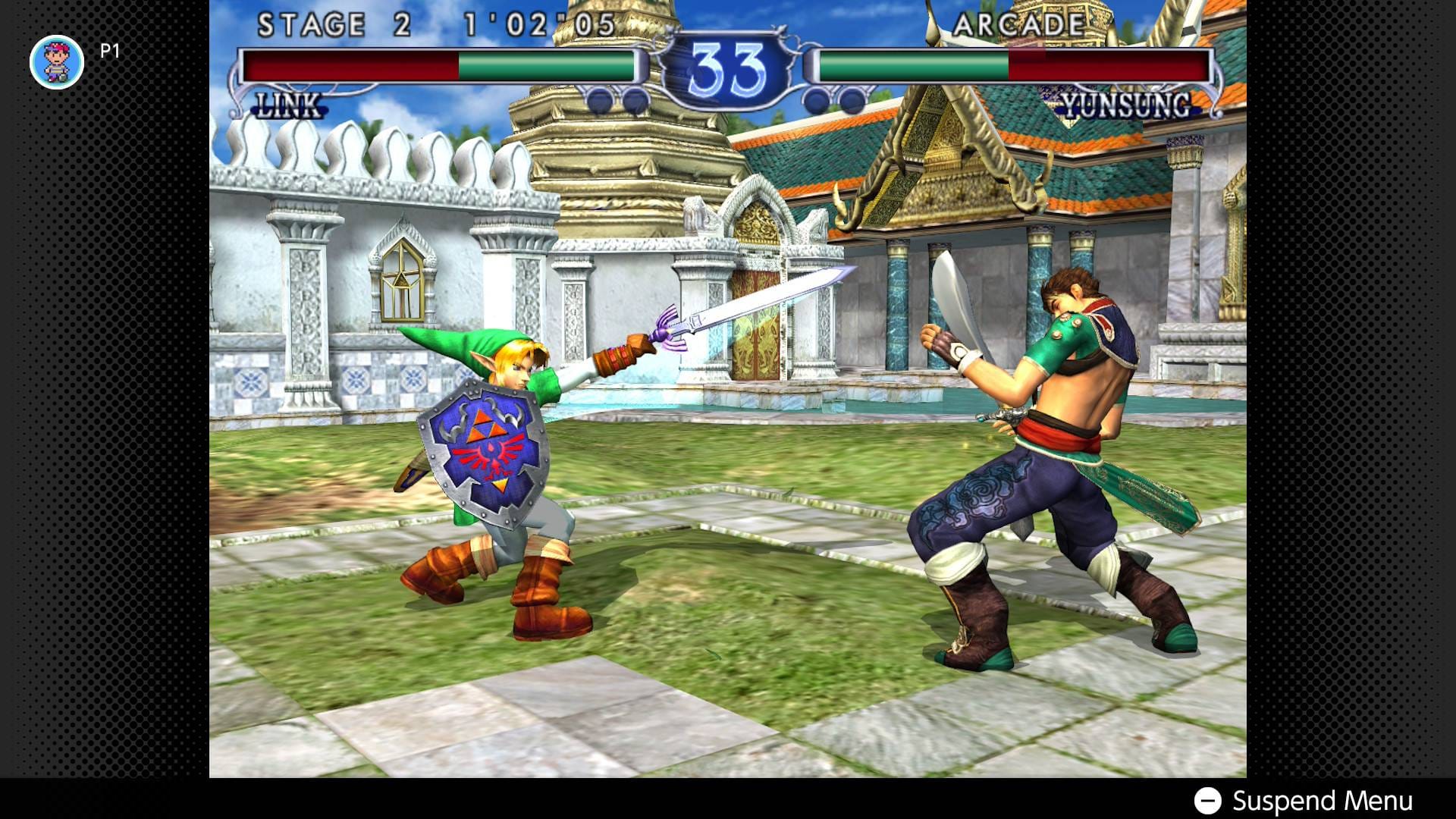
Play it and you’d understand, you may say. My chance came when a friend who’d fallen under SoulCalibur II’s spell brought it over once and twice, championing its majesty, going so far as to proclaim that he wished “to be buried with it.” (I’ve no clue if he still holds true to that promise) Alas, dear reader, I did not share in his enthusiasm: maybe the setting and artstyle didn’t appeal to a young me, or maybe the combat just didn’t click. Whatever the case, I was left thoroughly, utterly bored, leaving me all the more perplexed at the 9/10s and perfect scores thrown its way. What did people see in this dull-as-dirt fighter that I didn’t?
As I walked away shaking my head, the lightbulb sparked: SoulCalibur II was, surely, a passing fad, propped up only by virtue of Link’s star power. How else could the original have escaped my notice? Why else would this sequel have suddenly taken the gaming world by storm? That it quickly faded from my personal corner – be it lasting maybe two months in GameFAQs’s Top Ten GameCube Games listing to said friend dropping it like a rock -- only cemented my suspicions. Somehow, for all my time in gaming spaces, SoulCalibur II evaporated into a complete non-entity, its occasional citations among “Best GameCube games” or “Best fighting games” taken only as brow-raising incredulities.
Before you all draw your Soul Edges, know that I now heed that whole misconception as a lesson in how personal bubbles can craft some real silly confirmation biases. Obviously, SoulCalibur wouldn’t have six entries to its name if there wasn’t some quality to it – let alone if Hyrule’s champion didn’t feature in the succeeding entries -- and I’d like to think I’m humble enough to move past silly childhood grudges. If anything, I was delighted when SoulCalibur II was announced as Nintendo Classics’ third-party ambassador for its Gamecube library; really, what better way to mend fences than revisiting this acclaimed fighter with a more matured, forgiving mindset?

Unfortunately, there was one more roadblock: I don’t know how to play fighting games.
See, it doesn’t matter how many hours I put into training mode: the moment the match starts, the adrenaline kicks in, and any strategies and memorizations fly out the window as I tap the same tried-and-not-trues again and again. I can’t tell my zoners from your rushdowns, so forget about deducing optimal match-ups. Poor memory permanence renders input memorization a hopeless cause, and like every other freakin’ fighting game out there, SoulCalibur II insists on inscribing its moveset listings with attack prompts rather than actual controller buttons. Yes, I know it’s for universal readability, but so much for that when I still don’t know what a “medium attack” is! At least SoulCalibur II has the decency to assign directionals, but still, show me the damn buttons!
Witness the soaring beauty that is my #SoulCaliburII playstyle. #SoulCalibur2
— Anthony @ GamingTrend (MrSaturn99/Alagunder) (@anthonypsaturn.bsky.social) 2025-07-30T01:02:57.102Z
In other words, I’m the guy who Smash Bros. and Street Fighter VI’s Casual Mode was made for. As a writer, you can imagine the frustration in attributing poetics to the pitiful tactics I display above, let alone describing SoulCalibur II’s worth as a fighting game. With two decades’ worth of testimony from folks far more qualified than me, my job then is to elaborate upon other areas; namely, does the game feel good to play? Is it welcoming to newcomers? Is there enough content to keep me invested?
The verdict: yes, yes, and yes. SoulCalibur II, to my understanding, is hailed as the fastest game in the series, and not even NSO’s oft-maligned input lag can kill its momentum. Tight, fluid, and responsive, SoulCalibur II dispenses with fighting game conventions in supers and meters, testing your mettle in nothing but cutthroat bouts. Fret not a lack of spectacle, for the combatants swing their weapons to an ingrained rhythm much as they complement the senseless mashing of buttons.
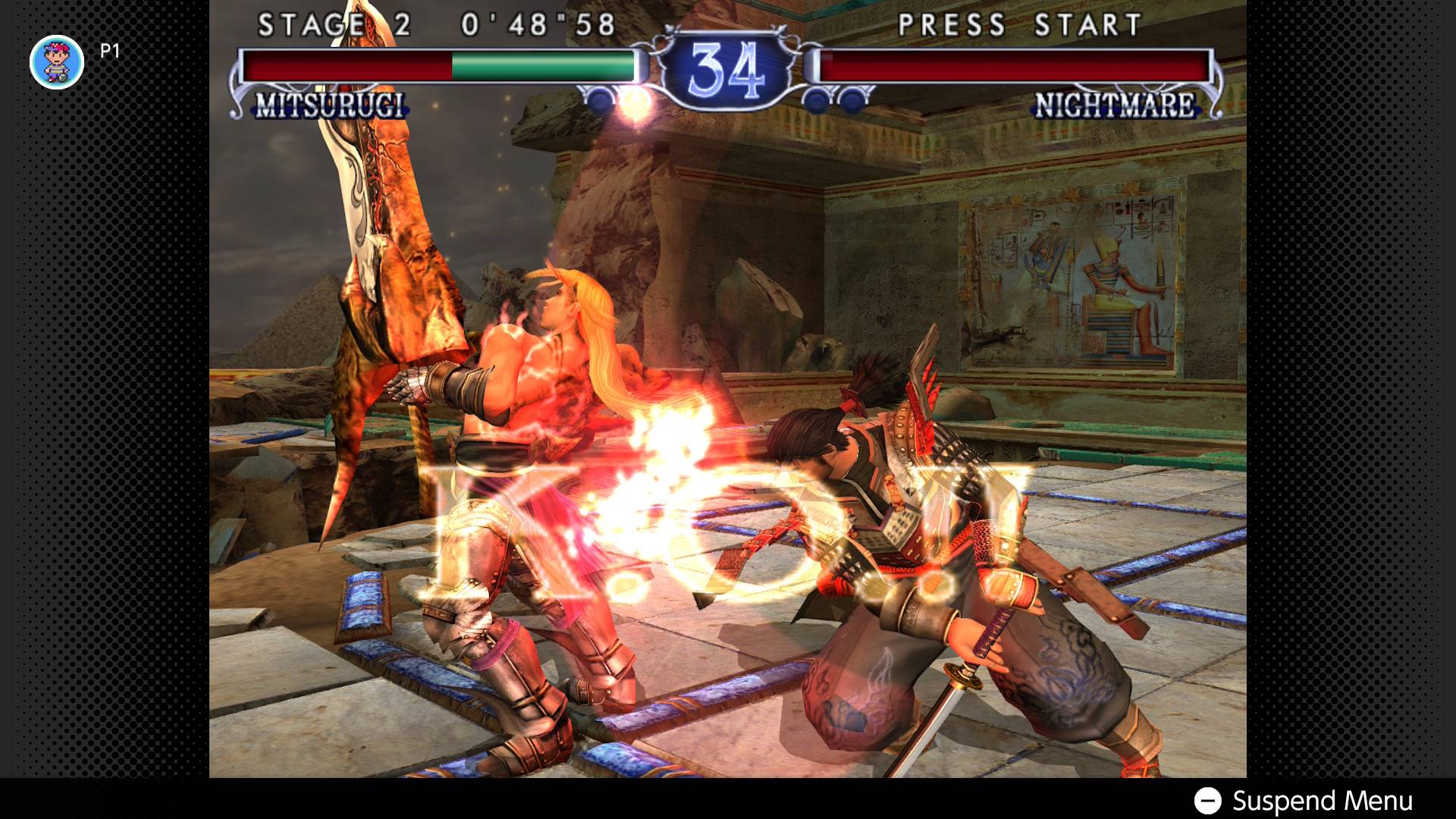
Like any great fighting game, one doesn’t need to memorize movesets and character match-ups to enjoy themselves. For instance, do I know how I got Talim to backflip mid-slice and slam her opponent head-first into the dirt? No, but boy, did it feel good. SoulCalibur II lays the groundwork for such theater with its 3D stage design: all are relatively featureless, their respective differences palpable only to the observant SoulCalibur scholar. No hazards, no interference – save the universal ledges frequently subject to hysterical ring-outs. (Ever had both characters fall off at once? Good times.)
Host to a varied roster starring twenty-four combatants, SoulCalibur II offers plenty for newcomers to sink their teeth into. – I still have no idea how to use Ivy’s stance-based whip play, for instance, but I can always fall back on more basic characters like samurai Mitsurugi if I’m overwhelmed. Link, naturally, was my first choice – his familiar repertoire of swordplay from the ever-reliable Spin Attack to the bouncy Sword Plant proved useful, but I couldn’t quite make sense of his expanded tools in bows and bombs. It wasn’t long before his ambassadorship to this strange new world was soon tossed aside for SoulCalibur II’s natives; namely, Talim – a young tribal priestess whose dual elbow blades and quick-footed acrobatics rendered her a reliable favorite.
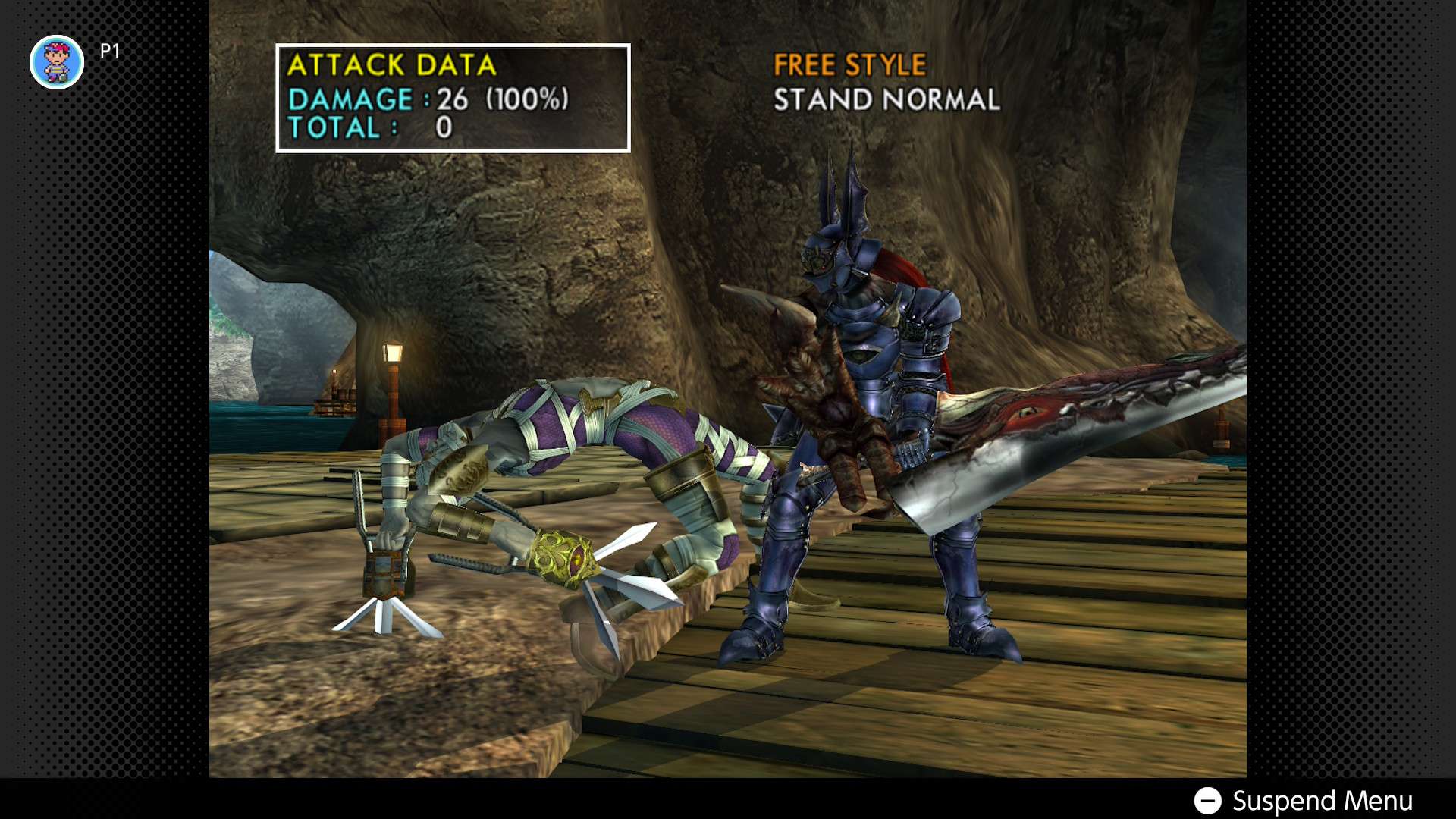
As opposed to its Namco cousin in Tekken, SoulCalibur II dispenses with comedy in its cast of hardened fighters, each with their respective mission statement delivered courtesy of cheesy dialogue. To the game’s credit, it fully commits to the bit: samurais, lady knights, and undead pirate captains all ooze coolness, each one introduced with poetic monologues of an ominous narrator. This is a historical fantasy drama, dang it, and a drama SoulCalibur II shall be – one that becomes all the more interesting when the game does embrace flamboyancy: the slithering enigma that is Voldo easily steals the show in how he’s practically crawled out of a horror movie, literally bending the laws of physics as his body twists and turns at impossible angles. And lest we forget how the masked Yoshimitsu gleefully radiates the comic energy missing from everyone else, right down to bouncing on his sword as a makeshift pogostick. (Perfect for endless spam, you understand.)
Not that there aren’t stinkers – Necrid, a Todd Macfarlane-designed monstrosity, remains the fandom punching bag for his tonal comic book dissonance, yet he’s such a non-entity that he’s an easily ignored pimple on the roster. Nay, my cringe lies mainly in SoulCalibur II’s overt sexualization: the likes of Taki and Ivy are beyond parody, adorned with jiggling breasts undermining this medieval clash. It’s difficult to judge who’s the bigger embarrassment, with Taki’s prominent nipples threatening to slip out of their sleeves to Ivy’s borderline-S&M outfit at odds with her dead-serious demeanor. Thank goodness there’s alt costumes; I’d never have taken them seriously otherwise. (Alas, the passage of time does that enough in dulling once-impressive animations – merely observe below how poor Xianghua can’t decide whether she’s swordfighting or playing limbo.)
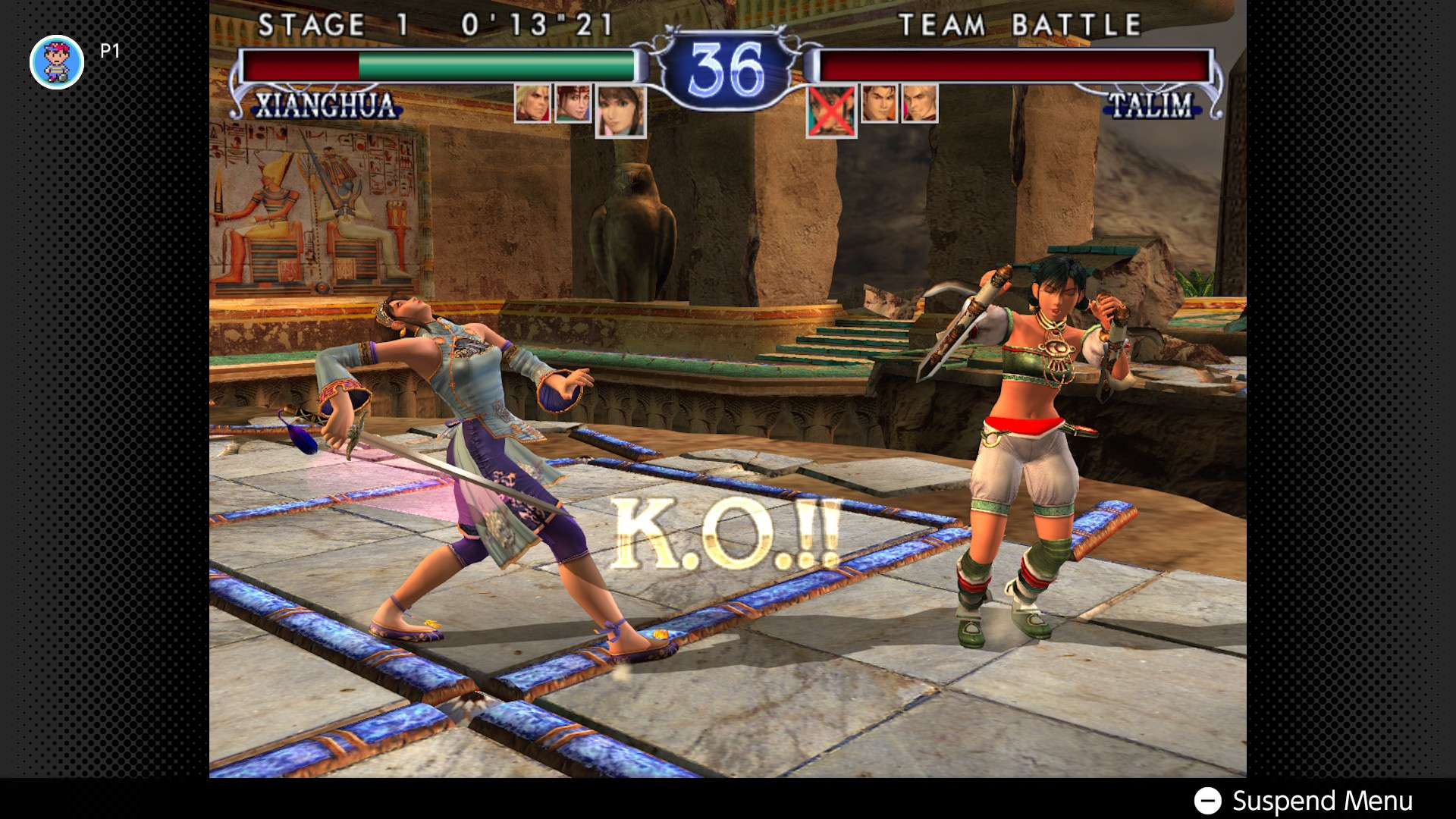
Much ado’s been made over Nintendo Classics’ input lag. Without access to the original game, I can’t make a direct comparison, but the concerns are obvious: an ultra-precise genre will depend on ultra-precise inputs for stringing combos, and veterans’ muscle memory will undoubtedly work against them here. As a newcomer, however, I never struggled outside of memorizing inputs, and any lost matches were merely strategic errors on my end. If you’re new to the game, you should be fine; if you’re a SoulCalibur II veteran, well, it may be a rough ride for you.
Anyway, strong combat, cool characters – all SoulCalibur II needs is a wealth of content to let us loose, and it provides just that. There’s your typical selection in Arcade and Practice alongside Time Attack (Set records in Arcade, complete with multiple difficulties), Survival (how long can you last against 50 sequential opponents?) and Team Attack (Pit your team against the computer’s – or even a friend’s). All are ripe for player experimentation, not the least in the Survival’s stymying difficulty; alas, yours truly can’t even get past ten fighters. How could anyone possibly clear fifty? Especially since there’s, uh, no pausing. No, really; the characters keep attacking if you pause. Why? What if nature calls? Thankfully, Switch 2’s Home button renders that misstep a thing of the past.
All great side-ventures, yet the real meat lies within the Weapon Master story mode. Framed as a narrative prequel to SoulCalibur proper, the player’s avatar – complete with a chosen name and any swappable character of their choosing -- sets out on a quest for the legendary Soul Edge, sending budding heroes across the map and pits them within inventive match-ups, from sequential one-on-five battles to navigating mine-filled battlefields.

Having played through to the end, it’s easy to see why it’s upheld as a fan-favorite mode: Weapon Master experiments with the boundaries of SoulCalibur II and tests the player accordingly. Even with its more gimmicky challenges, the mode threads the subtle needle of teaching the game’s mechanics whilst continually challenging the player. Earnable experience unlocks goodies in everything from new fighters to bonus chapters, encouraging would-be heroes to probe and poke about with different characters. The second-person narrative invokes the spirit of choose-your-own-adventure books, with the lack of portraits and voiced dialogue appealing to the player’s imagination. And if it’s not your jam, perfect – you can just skip it all and focus on the challenges before you.
And even on the rare chance those aren’t your jam, the unlockables certainly will be. Weapon Master feeds into the overall game by providing a treasure trove of weapons for the roster, all earned either from your hard-earned gold or completing certain missions. Their effects ranging from simple stat boosts to variant skills (longer reach, HP absorption, etc.), said weapons aren’t exclusive to Weapon Master – unlockable “Extra” versions of the single-player modes allow your new toys to get some exercise, leaving you with ample testing grounds to decide your favorite. With over 190 weapons to unlock, completionists have surely sunk countless hours collecting every last trinket.
It's big, it’s organic, it invites. For SoulCalibur II’s occasional design faults – no dedicated Vs. mode for single player irks – none impede upon its ultimate success: the seamless balance of appeal. The casual participant may not master the Mantis Crawl the way a dedicated enthusiast could, but they both enjoy the game’s bounty of riches all the same. The enthusiast collects and masters everything it has to offer with hard-won pride; the participant can gather at their own pace, seeking vindication merely in a preferred weapon or pulling off their favorite technique. Either warrior obtains satisfaction in climbing its towering peaks, of which there are no barriers to entry – only a higher level and/or bragging rights should the player so choose.
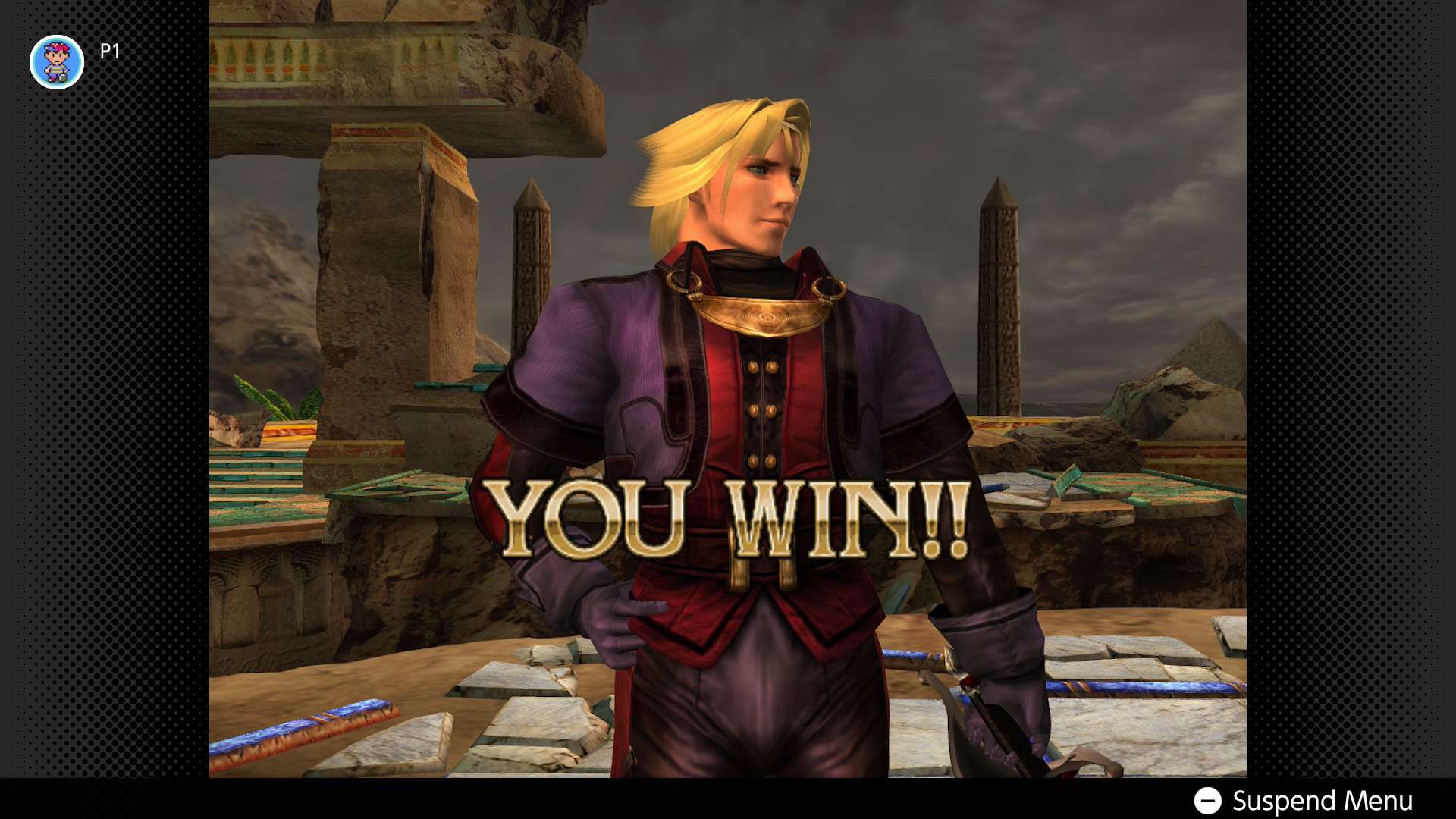
Is SoulCalibur II one of the greatest fighting games ever made? Given my aforementioned lack of expertise, I scarcely feel comfortable backing such a claim, but now I can finally – finally! – understand the veneration enduring so many years later. Contrary to the I can’t say it’s made me a SoulCalibur adherent, but it’s enough to casually enter the fray and enjoy how, as the official soundtrack would say, history unfolds.
